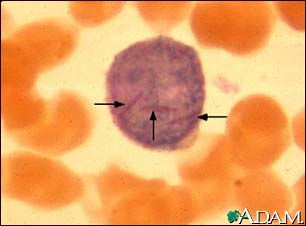Treatment
Treatment involves using medicines to kill the cancer cells. This is called chemotherapy. But chemotherapy kills normal cells, too. This may cause side effects such as excessive bleeding and an increased risk for infection. Your doctor may want to keep you away from other people to prevent infection.

Other treatments for AML may include:
* Antibiotics to treat infection
* Bone marrow transplant or stem cell transplant
* Red blood cell transfusions to fight anemia
* Transfusions of platelets to control bleeding
Most types of AML are treated the same way. However, a form of AML called acute promyelocytic leukemia (APL) is treated with a medicine called all-trans retinoic acid (ATRA). This medicine helps leukemia cells grow into normal white blood cells.
The drug arsenic trioxide is approved for use in patients with APL who do not get better with ATRA or chemotherapy.
Support Groups
See:
* Cancer support group
* Leukemia support group
Prognosis (Expectations)
When the signs and symptoms of AML go away, you are said to be in remission. Complete remission occurs in many patients.
With treatment, younger patients with AML tend to do better than those who develop the disease at an older age. The 5-year survival rate is much lower in older adults than younger persons. Experts say this is partly due to the fact that the body of a younger person may better tolerate strong chemotherapy medicines.
If the cancer does not come back (relapse) within 5 years of the diagnosis, you are considered permanently cured. Most of the time, the cancer returns within 2 years of diagnosis.
Complications
Complications of AML and cancer treatment include severe infections and life-threatening bleeding. Sometimes, the cancer comes back (relapses) after treatment.
Calling Your Health Care Provider
Call for an appointment with your health care provider if you develop symptoms of AML.
Call your health care provider if you have AML and have a fever that will not go away or other signs of infection.
Acute myeloid leukemia: Overview, Causes
Acute myeloid leukemia: Symptoms & Signs, Diagnosis & Tests
Acute myeloid leukemia Treatment
Reviewed By : David C. Dugdale, III, MD, Professor of Medicine, Division of General Medicine, Department of Medicine, University of Washington School of Medicine; and James R. Mason, MD, Oncologist, Director, Blood and Marrow Transplantation Program and Stem Cell Processing Lab, Scripps Clinic, Torrey Pines, California. Also reviewed by David Zieve, MD, MHA, Medical Director, A.D.A.M., Inc.
